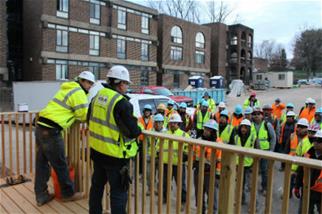 Photo courtesy of eLCOSH
Photo courtesy of eLCOSH
Construction work is some of the most hazardous of any industry sector. In 2015, construction fatalities accounted for 19 percent of the work-related deaths that year, more than any other industry. A challenge that contractors large and small face in addressing this issue is effectively communicating to workers the hazards they face on the job site, and the measures they can take to prevent injuries.
A key is ensuring that construction workers are trained to understand and identify the hazards associated with their work so that they can be mitigated or eliminated. One widely used training method is the so-called “toolbox talks,” wherein workers participate in 10- to 15-minute instructional sessions on different topics to learn the hazards associated with their work and the steps they can take to prevent incidents from occurring. This method is often a preferable training tool among smaller employers because they require minimal resources to deliver.
A recent study by U.S. Centers for Disease Control and Prevention (CDC) and NIOSH researchers examined the impact of toolbox talks, particularly those that include a narrative element, on the knowledge gain experienced by workers who participated.
The study included toolbox talks on eight common construction occupational safety and health concerns. These topics, developed by NIOSH for the purposes of the study, were determined based on the most high-risk activities in the construction industry:
- Preventing falls from roofs
- Preventing falls from extension ladders
- Preventing deaths from improper tool use
- Preventing falls from equipment or loads (forklifts)
- Preventing falls through holes in roofs and floors
- Preventing electrocutions: overhead power lines and boom cranes
- Preventing deaths from crushing: building materials
- Preventing deaths from skid-steer loaders
Working from these topics, the toolbox talks were presented in one of two formats. The first involved a more general discussion of the particular concern, followed by a list of appropriate safety measures and illustrations of relevant safety equipment.
The second format supplemented the content of the first format with a short narrative and questions asking workers whether they had been involved in such an incident, its consequences and how they could help prevent it at their current work site.
In all, nine companies with 16 work sites agreed to participate in the study. Each company was assigned either the narrative or non-narrative format to carry out the study. The toolbox talks were presented one per week for eight consecutive weeks. In total, 351 workers completed a baseline questionnaire prior to the study, which was designed to gauge their perspective on workplace safety at their site, as well as their knowledge of safety best practices.
207 participants completed a post-invention questionnaire to assess changes that were made relative to participating in the study. The study worked from the hypothesis that through the intervention participants would show significant gains in OSH knowledge and report an improved workplace safety culture. The researchers also hypothesized that participants in the narrative format would show greater gains in OSH knowledge, improvements in workplace safety culture and training impact compared to those in the non-narrative format.
The study found that both methods facilitated learning among the participants. However, it also found that including a narrative with discussion questions increased the overall knowledge gain when compared to those who received the non-narrative toolbox talks.
The researchers recommend that future studies test the effectiveness of toolbox talks with companies that have less positive safety cultures to address concerns about a possible ceiling effect, wherein the training is no longer having an impact, or the impact is not measurable. In addition, they suggest that effectiveness be measured for several months following the intervention.
Related Links
Adult Learners: Effective Training Methods
Safety Training Revisited: Effective Design & Delivery
Near-Hit Reporting: Reducing Construction Industry Injuries
Safety Training: The Case for a More Logical Practice